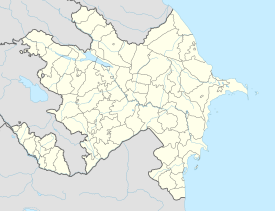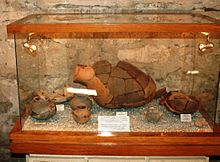This is an old revision of this page, as edited by Kpgjhpjm (talk | contribs) at 08:21, 1 November 2021 (Reverted edits by Oruspucocuklar (talk) to last version by Kpgjhpjm). The present address (URL) is a permanent link to this revision, which may differ significantly from the current revision.
Revision as of 08:21, 1 November 2021 by Kpgjhpjm (talk | contribs) (Reverted edits by Oruspucocuklar (talk) to last version by Kpgjhpjm)(diff) ← Previous revision | Latest revision (diff) | Newer revision → (diff)| This article's factual accuracy is disputed. Relevant discussion may be found on the talk page. Please help to ensure that disputed statements are reliably sourced. (July 2009) (Learn how and when to remove this message) |
| Church of Kish | |
|---|---|
| Church of Saint Elishe Müq. Yelisey Kilsəsi Holy Mother of God Church Tanrının Müqəddəs anası Kilsəsi | |
 | |
| Religion | |
| Affiliation | Georgian Orthodox Church |
| Ecclesiastical or organizational status | inactive (no parishioners), but mass held by Georgian priest |
| Location | |
| Location | |
 | |
| Geographic coordinates | 41°14′56″N 47°11′35″E / 41.248933°N 47.193067°E / 41.248933; 47.193067 |
| Architecture | |
| Completed | probably early 12th century AD |
| Dome(s) | 1 |
The Church of Kish (Template:Lang-az; Georgian: გიშის ეკლესია), also known from different sources as Church of Saint Elishe (Template:Lang-az, Template:Lang-hy; Latinised Saint Eliseus) or Holy Mother of God Church (Template:Lang-hy), is a Georgian Orthodox church, probably dating to the early 12th century, inactive due to lack of parishioners since the 19th century, although -as of 2000- mass was still regularly held by a Georgian priest. It is located in the village of Kiş approximately 5 km north of Shaki, Azerbaijan. Archaeological research undertaken in 2000 concluded that it was first built as a diophysite Georgian church, later to become a Chalcedonian church (Armenian or Caucasian Albanian). Previous research had proposed that it had functioned at different times as a Caucasian Albanian Apostolic church, a Chalcedonian church within the Georgian Orthodox Church, and later as an Armenian Apostolic Church.
History
According to the 7th century Armenian historian Movses Kaghankatvatsi, in the 1st century AD St. Elishe, a disciple of Thaddeus of Edessa, arrived to a place called Gis (Գիս), where he built a church and recited a liturgy. The church became the "spiritual center and the place of enlightenment of people of the East". On his way from Gis St. Elishe was killed near the pagan altar in the small Zerguni valley by unknown people. According to the Armenian historian on architecture Samvel Karapetian, the geographical position of Kish does not seem to match that described by Kaghankatvatsi. Karapetian believes that they have identified Gis as the village of Bomen/Bum 60 km to the south-east of Kish, in Gabala district.
According to a Georgian historiographer, in the 10th century, the population of Kish converted to the Georgian Orthodox Church (Chalcedonism). The church of Kish was turned into a residence of a Georgian bishop, functioning till 17th century. By the time when Russia took possession of the region the village of Kish had Udi population. According to Robert H. Hewsen, the Udi language appeared to have been prevalent north of Kura River until the nineteenth century, and the Armenian population appeared to be of relatively recent arrival. While many Armenians undoubtedly settled there fleeing the Turko-Mongolic invasions, many more entered the region with the coming of the Russians in the early nineteenth century.
The 18th century Georgian historian and geographer Prince Vakhushti Bagrationi provides interesting notes about the village of Kish and the church located therein: "Gishi lies at the foothills, it was a princedom of Tsuketi and had a large domed church, which was a sear of a bishop of Eliseni, Tsuketi and Shakikhi".
Research and dating

In 2000–2003 the Norwegian Ministry of Foreign Affairs funded a joint project between Azerbaijan Architecture and Construction University and the Norwegian Humanitarian Enterprise for the archaeological research and restoration of the church of Kish. Dr. Vilayat Karimov of Baku's Institute of Archaeology and Ethnography served as the director of excavations, and the archaeological advisor for the project was J. Bjørnar Storfjell. Radiocarbon analysis of various objects found on the site showed that the cultic site found beneath the altar of the church dates to about 3000 B.C., while the construction of the existing church building dates to about the 12th century (990–1160 A.D. calibrated Carbon-14 date).
The existing church building cannot be dated to the times of St. Elishe, but the archaeological evidence demonstrates that the church is located on an ancient cultic site. It is very unlikely that St. Elishe built in Kish a church in the modern understanding of this word. Even if the person did exist, it appears likely that he built only the altar or used an existing pagan cult structure.
Bjørnar Storfjell stated that there's clear evidence that this church was built as diophysite church. Excavations revealed that the church represented two different periods of use, with two different corresponding floor levels of the chancel area. A chancel (the altar area, where the priest officiates) only slightly elevated in comparison to the nave reflects a diophysite view on the nature of Christ (Jesus is seen as equally divine and human at the same time), while a higher elevation of the chancel is typical of Monophysitism (Christ is seen as purely divine). The officiating priest is seen as the representative of Jesus, and the Christological approach reflects on the priest's degree of proximity to the worshippers. In Kish, the floor level of the chancel was raised during a second period of use from a mere 30-40 cm to about one meter (100 cm) above that of the nave. According to Storfjell, the architecture of the apse of the original church in Kish suggests a diophysite Christology, and since the Georgian Church was the only diophysite church existing in the Caucasus in the late medieval period, it seems reasonable to suggest that the Kish church was initially built as a Georgian church and was later taken over by monophysites. At the time, the monophysite doctrine was represented in the region by two Churches: the Armenian and the Caucasus Albanian Church, the latter having adopted Monophysitism during the eighth century. Storfjell posits that the rising of the chancel floor to 1 meter above the nave floor level took place in the 17th century, while under the control of the Caucasus Albanian Church.
Gallery
-
 Plan of the church
Plan of the church
-
 West facade with entrance (2007)
West facade with entrance (2007)
-
 Church of Kish from the NE (rear view; 2007)
Church of Kish from the NE (rear view; 2007)
-
 Altar and dome (2011)
Altar and dome (2011)
-
 Dome with cross decoration and chandelier (2007)
Dome with cross decoration and chandelier (2007)
-
 Dome and chandelier (2011)
Dome and chandelier (2011)
-
 Crypt with burials (2007)
Crypt with burials (2007)
See also
References
- ^ Storfjell, Bjørnar. "The Church in Kish: Carbon Dating Reveals its True Age". Azerbaijan International. Los Angeles and Baku. pp. 33–39. Retrieved 1 June 2007.
- dqdk.gov.az Alban-udi xristian kilsəsi Archived 2009-09-28 at the Wayback Machine
- affa.az Azərbaycanda din
- baku-icc-2009.az Alban-Udi kilsəsi Archived 2009-06-08 at the Wayback Machine
- ^ Karapetian, Samvel. "Kish". Research on Armenian Architecture. Retrieved 2009-06-20.
- Wegge, Bjørn (2003). From Jerusalem to Gis: An investigation of the Eliseus-tradition in Courcasis. Paper Presented at the Conference Caucasus Albanians in the Past and Present. B. p. 35.
- Karimov, Vilayat; Storfjell, J. Bjørnar (2003). Киш. Б. (Kish. B.). p. 23. Retrieved 7 September 2011.
- Movses Kaghankatvatsi. History of Albania. Book 1, Chapter VI
- kvali.com Georgians, Armenians Row Over Vanishing Monuments Archived 2003-11-07 at the Wayback Machine
- Samvel Karapetian, "Research on Armenian Architecture", Online Version
- Игорь Кузнецов, "Удины".
- Robert H. Hewsen. "Ethno-History and the Armenian Influence upon the Caucasian Albanians," in: Samuelian, Thomas J. (Hg.), Classical Armenian Culture. Influences and Creativity, Chicago: 1982, 27-40.
- Official website of Baku eparchy of Russian Orthodox Church. Architectural heritage of Caucasian Albania
External links
- Research on Armenian Architecture: Kish village, Shaki District, Republic of Azerbaijan
- "About the Kish Church Reconstruction Project", Azerbaijan International, Vol. 11:1 (Spring 2003), p. 33.
- The Kish Church: Digging up History: Norwegians Help Restore Ancient Church, Azerbaijan International, Vol. 8:4 (Winter 2000), pp. 18–19.
- Photos the Church of Kish
- "The Church in Kish: Carbon Dating Reveals its True Age," Azerbaijan International, Vol. 11:1 (Spring 2003), pp. 33–39.
- Trip to Kish church
- Detailed recording from the Kish church
| Caucasian Albanian churches and monasteries in Azerbaijan | |
|---|---|
| Georgian cathedrals, monasteries and churches in Azerbaijan | |
|---|---|



